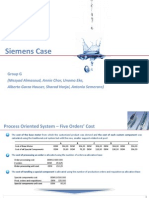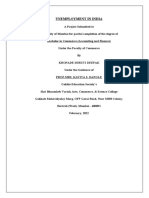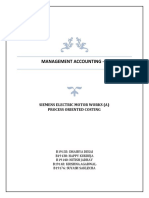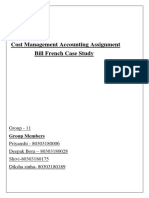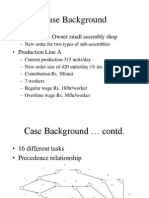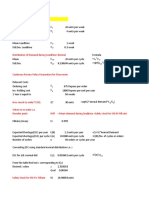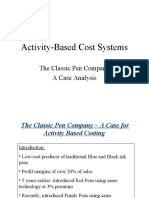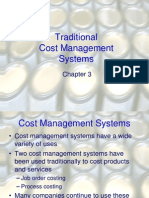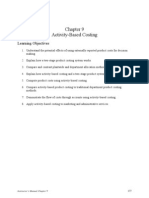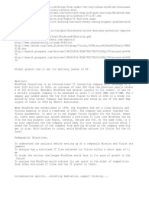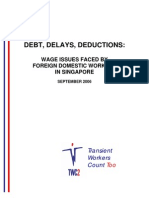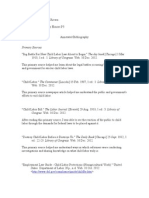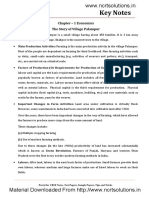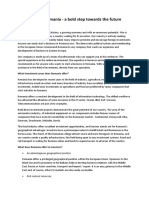Siemens Case
Siemens Case
Uploaded by
spaw1108Copyright:
Available Formats
Siemens Case
Siemens Case
Uploaded by
spaw1108Original Description:
Copyright
Available Formats
Share this document
Did you find this document useful?
Is this content inappropriate?
Copyright:
Available Formats
Siemens Case
Siemens Case
Uploaded by
spaw1108Copyright:
Available Formats
On all what counts the Prokasta was different from the old costing system? 1.
Two new cost pools for support related costs Prokasta System was a process oriented costing system in which two new cost pools were introduced Costs related to Order Processing o Billing o Order Receiving o Product Costing and bidding o Shipping Costs related to Special Components o Inventory Handling o Product Costing and bidding o Product Development o Purchasing o Receiving o Scheduling and Production Control o Technical Examination of Incoming Orders
After Siemens changed its strategy to move from production of standard motors to customized motors, the support related costs increased. Though the number of orders increased, the number of motors per order reduced increasing the load on production support. Under the old costing system, the support related overheads were allocated to each motor based on its consumption of direct materials, direct labor and either direct or indirect labor or machine hours. But in Prokasta system, two new cost pools were created to assign the overheads based on number of orders received and number of special components in the order. 2. Determining factory cost and transfer price The new Prokasta system was used to determine Factory Cost and price at which motors were transferred from EMW to Sales Division (transfer price of the motors).
How did it support new strategy?
In 1985, EMW decided to move from the production of standard motors to the production of low volume customized motors. While implementing this strategy management realized the old systems inability to capture the relation between the increased support costs and the change in product mix. Under the old costing system, the support related overheads were allocated to each motor based on its consumption of direct materials, direct labor and either direct or indirect labor or machine hours. In reality, the support costs increased as the number of orders increased but the number of motors per order reduced. So the support related costs were driven by number of orders and number of special components in an order. In the Prokasta system, two new cost pools were created to assign the overheads based on number of orders received and number of special components in the order. It helped managers determine which orders were profitable and which were unprofitable. It also helped to determine the price at which motors were transferred from EMW to Sales Division. This is how the new Prokasta costing system supported the new strategy.
Do you agree with Siemenss decision to set up both sales and EMW as profit Centre? What are the cost and benefits? The decision to set up both Sales and EMW as profit Centre had following costs and benefits: Costs Separate profit centers for Sales and EMW caused them to ensure profitability of their own divisions rather than the overall profitability of the business. The revenues from each order were split between EMW and Sales to ensure the breakeven for both. This actually reduced the actual profitability of EMW. The selling price was decided by Sales division based on relationship with customer, competitive prices and other factors rather than the cost of production, sometimes causing losses on the orders.
Benefits Helps in assessment of profitability of Sales and EMW division separately The selling price is set based on market demand, price set by competitors and relationship with the customer as the Sales division decides the selling price.
Does transfer pricing system make sense? Why do you think so?
The transfer price was calculated as follows: Factory Cost = Standard Cost per unit (from Prokasta costing system) * Discount Factor If the factory cost > Selling Price Transfer Price = Factory Cost + 1/3* Profit If the factory cost < Selling Price Transfer Price = Variable Cost + 3/4* Contribution There are few critical issues with the transfer pricing system: 1. The Selling price is set by the Sales division based on the relationship with the customer, competitive prices and other factors. Sometimes this price was lower than the factory cost thus causing loss on that order. 2. These selling prices were also recorded in the catalogues and thus used next time similar orders are accepted. So even if the selling price was lower than factory cost in the first place, it was used again and again for similar orders. 3. Instead of trying to increase the profits on an order, the transfer pricing was just dividing the profits/contribution gained on the order between EMW and Sales. Thus the transfer pricing was faulty and needed to be changed.
You might also like
- 6th Central Pay Commission Salary CalculatorDocument15 pages6th Central Pay Commission Salary Calculatorrakhonde100% (436)
- SiemensDocument10 pagesSiemenssharadharjai100% (2)
- Bergerac Case AnalysisDocument12 pagesBergerac Case Analysissiddhartha tulsyan100% (1)
- How Does Wilkerson's Existing Cost System Operate? Develop A Diagram To Show How Costs Flow From Factory Expense Accounts To ProductsDocument4 pagesHow Does Wilkerson's Existing Cost System Operate? Develop A Diagram To Show How Costs Flow From Factory Expense Accounts To ProductsKunal DhageNo ratings yet
- Davey Brothers Watch Co. SubmissionDocument13 pagesDavey Brothers Watch Co. SubmissionEkta Derwal PGP 2022-24 Batch100% (1)
- Unemployment in IndiaDocument67 pagesUnemployment in IndiaG-TYBAF-31-SHRUTI -KNo ratings yet
- DocxDocument3 pagesDocxbilalNo ratings yet
- WilkDocument3 pagesWilkMohammed Maaz GabburNo ratings yet
- Group 8Document20 pagesGroup 8nirajNo ratings yet
- Siemens Coma CaseDocument5 pagesSiemens Coma Caseshshank pandeyNo ratings yet
- Activity-Based Costing Classic Pen CaseDocument73 pagesActivity-Based Costing Classic Pen CaseRohin Kesar100% (4)
- Classic PenDocument15 pagesClassic PenAnkur MittalNo ratings yet
- Cisco System Inc - Q&AsDocument3 pagesCisco System Inc - Q&AsRishabh Kumar100% (1)
- Griffin Mgmt12e IM Ch10Document16 pagesGriffin Mgmt12e IM Ch10Srinivas RaoNo ratings yet
- SiemensDocument7 pagesSiemensshshank pandeyNo ratings yet
- Seimens Electric Motor WorksDocument5 pagesSeimens Electric Motor WorksShrey BhalaNo ratings yet
- Manac Asn1 SiemensDocument5 pagesManac Asn1 SiemensNikhil Jindal100% (1)
- Davey & Classic Pen CA - Abhishek - .2022B2PGPMX001docxDocument4 pagesDavey & Classic Pen CA - Abhishek - .2022B2PGPMX001docxabhishek pattanayakNo ratings yet
- Wilkerson CompanyDocument4 pagesWilkerson Companyabab1990No ratings yet
- Siemens ElectricDocument6 pagesSiemens ElectricUtsavNo ratings yet
- Dave BrothersDocument6 pagesDave BrothersSangtani PareshNo ratings yet
- MAC Davey Brothers - AkshatDocument4 pagesMAC Davey Brothers - AkshatPRIKSHIT SAINI IPM 2019-24 BatchNo ratings yet
- Wilkerson - Case Study1 PDFDocument2 pagesWilkerson - Case Study1 PDFPavanNo ratings yet
- Siemens Electric Motor WorksAQ PDFDocument3 pagesSiemens Electric Motor WorksAQ PDFHashirama SenjuNo ratings yet
- Wilkerson CaseDocument4 pagesWilkerson CaseChiara RibeiroNo ratings yet
- DakotaDocument5 pagesDakotaMadhavi SerenityNo ratings yet
- Case AnalysisDocument3 pagesCase AnalysisBadri100% (2)
- Cost Management Accounting Assignment Bill French Case StudyDocument5 pagesCost Management Accounting Assignment Bill French Case Studydeepak boraNo ratings yet
- Management Accounting Wilkerson Company CasestudyDocument3 pagesManagement Accounting Wilkerson Company CasestudysamacsterNo ratings yet
- Wilkerson Case Assignment Questions Part 1Document1 pageWilkerson Case Assignment Questions Part 1gangster91No ratings yet
- Implementing Target CostingDocument31 pagesImplementing Target CostingJonnattan MuñozNo ratings yet
- PIA Hawaii Emirates Easy Jet: Breakeven AnalysisDocument3 pagesPIA Hawaii Emirates Easy Jet: Breakeven AnalysissaadsahilNo ratings yet
- Shweta Kale Section - B 2019PGP401 Siemens Electric Motor WorksDocument8 pagesShweta Kale Section - B 2019PGP401 Siemens Electric Motor WorksshwetaNo ratings yet
- Operation and Product ManagementDocument2 pagesOperation and Product ManagementIbrahim JawedNo ratings yet
- Case Background: - Mrs. Santha - Owner Small Assembly Shop - Production Line ADocument12 pagesCase Background: - Mrs. Santha - Owner Small Assembly Shop - Production Line AAbhishek KumarNo ratings yet
- Dakota Office ProductsDocument10 pagesDakota Office ProductsMithun KarthikeyanNo ratings yet
- Wilkerson Company ABC Cost System Exhibit 1.a Cost Pool Cost DriverDocument2 pagesWilkerson Company ABC Cost System Exhibit 1.a Cost Pool Cost DriverLeonardoGomez100% (1)
- Case 18-1 Huron Automotive Company StudyDocument4 pagesCase 18-1 Huron Automotive Company StudyEmpress CarrotNo ratings yet
- Dakota Office ProductsDocument10 pagesDakota Office ProductsNidhi BhartiaNo ratings yet
- Case4 - Wilkerson CompanyDocument24 pagesCase4 - Wilkerson CompanyCik Beb Gojes100% (1)
- EX 1 - WilkersonDocument8 pagesEX 1 - WilkersonDror PazNo ratings yet
- Cost Management - Software Associate CaseDocument7 pagesCost Management - Software Associate CaseVaibhav GuptaNo ratings yet
- Steel Frame FurnitureDocument17 pagesSteel Frame FurnitureDev AnandNo ratings yet
- Don't Bother MeDocument13 pagesDon't Bother MeMrinal KumarNo ratings yet
- Dakota Case SolutionDocument6 pagesDakota Case SolutionKamruzzamanNo ratings yet
- Aries Agro Limited Case StudyDocument10 pagesAries Agro Limited Case StudySelwin DsouzaNo ratings yet
- Activity-Based Cost Systems: The Classic Pen Company A Case AnalysisDocument14 pagesActivity-Based Cost Systems: The Classic Pen Company A Case AnalysisSarveshwar Sharma50% (2)
- Wilkerson CompanyDocument2 pagesWilkerson CompanyAnkit VermaNo ratings yet
- Saurav Das - 046 - Eprocurement at Cathay Pacific AirwaysDocument5 pagesSaurav Das - 046 - Eprocurement at Cathay Pacific AirwaysSaurav Arikadoshikaru DasNo ratings yet
- Cci CaseDocument3 pagesCci CaseDanielle Eller BurnettNo ratings yet
- Group No. 10 - DMK Assignment HubbleDocument7 pagesGroup No. 10 - DMK Assignment HubbleKunal SehgalNo ratings yet
- Alexander Monte Mile High Cycles Case ReportDocument6 pagesAlexander Monte Mile High Cycles Case Reportalexmonte100% (1)
- The Merit Corporation IDocument2 pagesThe Merit Corporation IMOHIT MALVIYA PGP 2020 BatchNo ratings yet
- Insteel Wire ProductsDocument8 pagesInsteel Wire ProductsSwapnika Nag100% (1)
- Case AnalysisDocument11 pagesCase AnalysisSrinivasan IyerNo ratings yet
- Millichem Solution XDocument6 pagesMillichem Solution XMuhammad Junaid100% (1)
- BSE CaseDocument2 pagesBSE CaseSwadesh -No ratings yet
- Executive Shirt CompanyDocument6 pagesExecutive Shirt CompanyPramod kNo ratings yet
- Corning Inc.: Submitted By: Nishant Singh (E058)Document2 pagesCorning Inc.: Submitted By: Nishant Singh (E058)PratikJainNo ratings yet
- Traditional Cost Management ModelsDocument15 pagesTraditional Cost Management ModelsfaisNo ratings yet
- Traditional Cost Management SystemsDocument62 pagesTraditional Cost Management SystemsaaawhsascribdNo ratings yet
- ACCY121FinalExamInstrManualchs9!11!13 16 AppendixDocument115 pagesACCY121FinalExamInstrManualchs9!11!13 16 AppendixArun MozhiNo ratings yet
- Milat TractorsDocument10 pagesMilat TractorsUzair ShahNo ratings yet
- World's Leader Gigawatts: PaymentsDocument1 pageWorld's Leader Gigawatts: Paymentsspaw1108No ratings yet
- Introduction ESHDocument2 pagesIntroduction ESHspaw1108No ratings yet
- Research Looks The Most Apt. It Is An Exhaustive Form of Research Which Clearly Defines The WhoDocument1 pageResearch Looks The Most Apt. It Is An Exhaustive Form of Research Which Clearly Defines The Whospaw1108No ratings yet
- Investment in Technology To Increase Yield of The SeedsDocument2 pagesInvestment in Technology To Increase Yield of The Seedsspaw1108No ratings yet
- Which Model Is "Linear" in Case of Linear Regression?Document1 pageWhich Model Is "Linear" in Case of Linear Regression?spaw1108No ratings yet
- Wipro Paper (System Software) July-1997Document1 pageWipro Paper (System Software) July-1997spaw1108No ratings yet
- Parameters Wtg. Ipts Brts LRT: Total 100% 3.06 2.69 2.1Document2 pagesParameters Wtg. Ipts Brts LRT: Total 100% 3.06 2.69 2.1spaw1108100% (1)
- ExhibitDocument1 pageExhibitspaw1108No ratings yet
- APMC FinalDocument43 pagesAPMC Finalsweetesha78% (9)
- Mind TreeDocument2 pagesMind Treespaw1108No ratings yet
- California-Based Restaurant Chain Offering Made-To-Order Sandwich Wraps Using Fresh, Healthy IngredientsDocument2 pagesCalifornia-Based Restaurant Chain Offering Made-To-Order Sandwich Wraps Using Fresh, Healthy Ingredientsspaw1108No ratings yet
- Budget PreparationDocument3 pagesBudget Preparationspaw1108No ratings yet
- Selected Eco IndicatorsDocument6 pagesSelected Eco Indicatorsspaw1108No ratings yet
- The Questions Typically Asked in The Application Forms of Various Companies Last Year WereDocument2 pagesThe Questions Typically Asked in The Application Forms of Various Companies Last Year Werespaw1108No ratings yet
- Does Mcdonald HV Anytg To Offer To BusinessesDocument7 pagesDoes Mcdonald HV Anytg To Offer To Businessesspaw1108No ratings yet
- Applied EconomicsDocument144 pagesApplied EconomicsRexijay PagatpatNo ratings yet
- Labor Mobility ReportDocument63 pagesLabor Mobility ReportChelle CorrigeNo ratings yet
- CA Final - Costing - Question Booklet PurushottamDocument94 pagesCA Final - Costing - Question Booklet PurushottamAnju GoyalNo ratings yet
- Caie Igcse Economics 0455 Theory v1Document16 pagesCaie Igcse Economics 0455 Theory v1Mehri MustafayevaNo ratings yet
- Final 2015Document8 pagesFinal 2015rtchuidjangnanaNo ratings yet
- Ali 2017Document25 pagesAli 2017daniloNo ratings yet
- Managerial Economics: Production Function Group ActivityDocument8 pagesManagerial Economics: Production Function Group ActivityFranchel DakisNo ratings yet
- Dearness Allowance (D.A)Document12 pagesDearness Allowance (D.A)vigneshNo ratings yet
- Debt Delays Deductions: Wage Issues Faced by Foreign Domestic Workers in Singapore (Sep06)Document32 pagesDebt Delays Deductions: Wage Issues Faced by Foreign Domestic Workers in Singapore (Sep06)Transient Workers Count TooNo ratings yet
- Annotated BibliographyDocument10 pagesAnnotated Bibliographyapi-196776169No ratings yet
- Chapter 8 TestbankDocument26 pagesChapter 8 TestbankBùi Thị Vân Anh 06No ratings yet
- Summary Notes On Unemployment From MankiwDocument3 pagesSummary Notes On Unemployment From MankiwChadia Laurent-MathurinNo ratings yet
- Final ExaminationDocument3 pagesFinal ExaminationZia SmithNo ratings yet
- BUS208 Microeconomics For ManagersDocument28 pagesBUS208 Microeconomics For ManagersrahimNo ratings yet
- Chapter - 1 Economics The Story of Village Palampur: Portal For CBSE Notes, Test Papers, Sample Papers, Tips and TricksDocument2 pagesChapter - 1 Economics The Story of Village Palampur: Portal For CBSE Notes, Test Papers, Sample Papers, Tips and TricksHarsh kumarNo ratings yet
- ESO13-20 Division of Labour Durkheim and MarxDocument20 pagesESO13-20 Division of Labour Durkheim and MarxakshatgargmoderniteNo ratings yet
- Chapter 02 SlidesDocument38 pagesChapter 02 SlidesSaad HassanNo ratings yet
- Activity 2 TCWDocument2 pagesActivity 2 TCWFranchesca alex ReyesNo ratings yet
- MNC Nep PresentationDocument53 pagesMNC Nep PresentationSaajan RathodNo ratings yet
- OM 1-MergedDocument124 pagesOM 1-MergedMukul TomarNo ratings yet
- Invest in RomaniaDocument3 pagesInvest in RomaniaGabriella RichterNo ratings yet
- Structural UnemploymentDocument2 pagesStructural Unemploymentzainab MuhammadNo ratings yet
- Is Capitalism Solution To IndiaDocument12 pagesIs Capitalism Solution To IndiaAnonymous 2UkkQDNo ratings yet
- M2 Lesson 2 The Family and Womens Oppression1Document20 pagesM2 Lesson 2 The Family and Womens Oppression1raymond garovillasNo ratings yet
- Calamba Medical Center VS National Labor Relations Commission 571 SCRA 585 (2008)Document30 pagesCalamba Medical Center VS National Labor Relations Commission 571 SCRA 585 (2008)Princess MagpatocNo ratings yet
- F5 Cenit Online Notes P1Document23 pagesF5 Cenit Online Notes P1Izhar MumtazNo ratings yet
- Nike Code Leadership Standard September 2017 EnglishDocument168 pagesNike Code Leadership Standard September 2017 EnglishPhạm DungNo ratings yet
- Principles of Labour WelfareDocument6 pagesPrinciples of Labour WelfareArbab Niyaz KhanNo ratings yet

